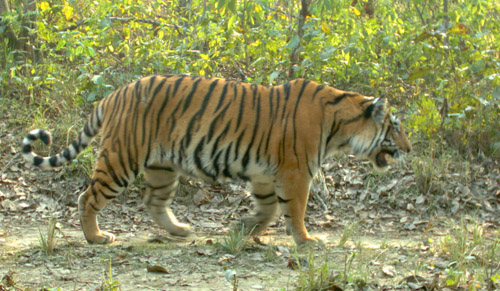Twelve years ago, a team led by Jianguo “Jack” Liu at Michigan State University showed that China needed to revisit how it was protecting its pandas. Now research on tiger habitat in Nepal, published in Ecosphere journal of the Ecological Society of America, again shows that conservation demands not only good policy, but also monitoring even years down the road.
“Understanding long-term outcomes of conservation programs is crucial and requires innovative methods,” Liu said. “Now we’re learning that Nepal’s outstanding efforts to protect tigers are best supported with close monitoring because conservation situations are so dynamic. In both cases, the key is to understand how the people who live near the valued wildlife are faring as well.”
Neil Carter, who recently received a doctoral degree from MSU‘s Center for Systems Integration and Sustainability, has spent years studying endangered tigers in Chitwan National Park in Nepal’s Himalayan lowlands. The park, established in 1973 to protect both the tigers and the area’s biodiversity, was not without cost to the people who live around the area. Those residents depend on the same forests for wood for fuel and building and grasses to thatch roofs and feed their livestock, and the policies that govern it are top-down, with little input from residents.

Conservation demands not only good policy, but also monitoring even years down the road. Image courtesy of MSU
In 1996, Nepal added a buffer zone next to the park to both improve the area’s ecosystem and help improve the livelihoods of the people who live there. In the buffer zone, people are allowed both more access to the forest’s resources and more say in its management.
Tigers like grasslands, which support high prey numbers and likely give tigers cover to hunt their prey. Because tigers require large areas, they prefer their cover not be too broken up.
Turns out that human populations around Nepal are growing, and with that increasing unauthorized human use of local natural resources, is reducing the quality of tiger habitat inside Chitwan National Park. The tigers are finding friendly neighborhoods outside the park – which is important input, both for the buffer’s policies and the park’s policies.
“Many animals have their ranges extending outside of protected areas,” Carter said. “They don’t know and they don’t care where the border signs are. So areas outside protected areas are important as well.
Carter is now a research associate at the National Socio-Environmental Synthesis Center in Annapolis, Md, and Princeton University.
Additional researchers who contributed to the study included: Bhim Gurung of the Nepal Tiger Trust in Chitwan; Andrés Viña, an assistant professor in CSIS; Henry Campa, professor of wildlife ecology; and Jhamak Karki of Nepal’s Department of National Parks and Wildlife Conservation.
The research was funded by the National Science Foundation, the U.S. Fish and Wildlife Service Rhinoceros and Tiger Conservation Fund, NASA’s Earth and Space Science program and MSUs AgBioResearch.
*Source: Michigan State University
